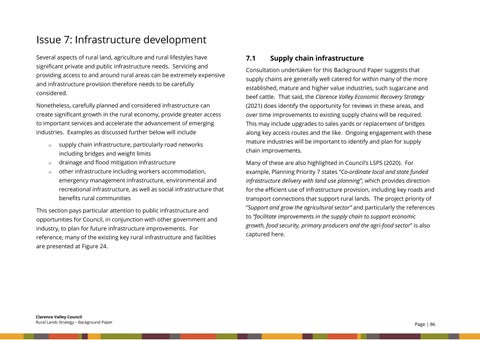Issue 7: Infrastructure development Several aspects of rural land, agriculture and rural lifestyles have significant private and public infrastructure needs. Servicing and providing access to and around rural areas can be extremely expensive and infrastructure provision therefore needs to be carefully considered.
7.1
Supply chain infrastructure
Consultation undertaken for this Background Paper suggests that supply chains are generally well catered for within many of the more established, mature and higher value industries, such sugarcane and beef cattle. That said, the Clarence Valley Economic Recovery Strategy
Nonetheless, carefully planned and considered infrastructure can
(2021) does identify the opportunity for reviews in these areas, and
create significant growth in the rural economy, provide greater access
over time improvements to existing supply chains will be required.
to important services and accelerate the advancement of emerging
This may include upgrades to sales yards or replacement of bridges
industries. Examples as discussed further below will include
along key access routes and the like. Ongoing engagement with these
o
supply chain infrastructure, particularly road networks including bridges and weight limits
mature industries will be important to identify and plan for supply chain improvements.
o
drainage and flood mitigation infrastructure
Many of these are also highlighted in Council’s LSPS (2020). For
o
other infrastructure including workers accommodation,
example, Planning Priority 7 states “Co-ordinate local and state funded
emergency management infrastructure, environmental and
infrastructure delivery with land use planning”, which provides direction
recreational infrastructure, as well as social infrastructure that
for the efficient use of infrastructure provision, including key roads and
benefits rural communities
transport connections that support rural lands. The project priority of
This section pays particular attention to public infrastructure and opportunities for Council, in conjunction with other government and industry, to plan for future infrastructure improvements. For reference, many of the existing key rural infrastructure and facilities
“Support and grow the agricultural sector” and particularly the references to “facilitate improvements in the supply chain to support economic growth, food security, primary producers and the agri-food sector” is also captured here.
are presented at Figure 24.
Clarence Valley Council Rural Lands Strategy – Background Paper
Page | 86














